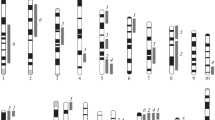Abstract
The physiological actions of the gene controlling the predisposition to stereotypic hyperkinesia in the form of pendulum-like movements (PM) and, probably, a form of spontaneous nystagmus in rats with albinism are manifest as a number of behavioral characteristics (total motor activity, emotionality, startle reflex intensity, sensitivity to serotonin 5-HT2 receptors as assessed in terms of the intensity of head twitching, and predisposition to cataleptic responses). A number of parameters showed differences between hybrids of gray handling-tolerant rats and carriers of the PM gene on the one hand, and between gray rats and animals not carrying the PM gene on the other. Some behavioral characteristics of rats with PM were closer to those of Wistar rats than to those of rats without PM. This, as well as the high frequency of PM in Wistar rats, indicates that the gene responsible for the manifestations of PM is not pathological, but controls a variety of adaptive features of the nervous system. The interaction between PM and the predisposition to catalepsy is biphasic in nature and is described by a curve in the form of an inverted U.
Similar content being viewed by others
REFERENCES
N. N. Barykina, T. I. Aksenovich, T. A. Alekhina, V. F. Chugui, and V. G. Kolpakov, "The inheritance of 'pendulum-like' movements in rats," Genetika (in press).
N. N. Barykina, V. G. Kolpakov, T. A. Alekhina, and I. L. Chepkasov, "The genetic link between catalepsy and pendulum-like movements and audiogenic epilepsy in rats," Genetika, 11, 1818–1823 (1984).
S. N. Davidenkov, Evolutionary Genetic Questions in Neuropathology [in Russian], Leningrad (1947).
V. G. Kolpakov, Catatonia in Animals [in Russian], Nauka, Novosibirsk (1990).
V. G. Kolpakov, N. N. Barykina, P. M. Borodin, and L. I. Serova, "Jactatio capitis < movement stereotypy in rodents," Genetika, 1, 71–77 (1976).
A. L. Markel', "Assessment of the major characteristics of rat behavior in an 'open field test'," Zh. Vyssh. Nerv. Deyat., 31, 301–307 (1981).
N. K. Popova, N. N. Barykina, I. F. Plyusnina, T. A. Alekhina, and V. G. Kolpakov, "Expression of startle reactions in rats genetically predisposed to different types of protective behavior," Ros. Fiziol. Zh. im. I. M. Sechenova, 49, 99–104 (1999).
N. K. Popova, A. V. Kulikov, V. G. Kolpakov, N. N. Barykina, and T. A. Alekhina, "Changes in the serotonin system of the brain in rats genetically predisposed to catalepsy," Zh. Vyssh. Nerv. Deyat., 35, 742–746 (1985).
P. F. Rokitskii, Biological Statistics [in Russian], Vysheishaya Shkola, Minsk (1973).
G. Sel'e, At the Whole-Body Level [in Russian], Nauka, Moscow (1972).
V. A. Shul'ga, N. N. Barykina, T. A. Alekhina, and V. G. Kolpakov, "Some physiological characteristics of the genetic predisposition to catalepsy depending on the stage of selection," Ros. Fiziol. Zh. im. I. M. Sechenova, 82, No. 1, 77–83 (1996).
H. Collewijn, P. Apkarian, and H. Spekreijse, "The oculomotor behaviour in human albinos," Brain, 108, 1–28 (1985).
R. W. Guillery, G. L. Scow, B. M. Cattanach, and M. S. Deol, "Genetic mechanisms determining the visual pathways in mice," Science, 179, 1014–1016 (1973).
B. L. Jacobs, "Minireview: an animals behaviour model for studying serotonergic synapses," Life Sci., 19, 777 (1976).
V. G. Kolpakov, N. N. Barykina, T. A. Alekhina, and I. L. Chepkasov, "Catalepsy in rats: its inheritance and relationship to pendulum movements and audiogenic epilepsy," Behav. Proc., 10, 63–76 (1985).
V. G. Kolpakov, N. N. Barykina, T. A. Alekhina, and I. Yu. Ponomarev, Some Genetic Animal Models for Comparative Psychology and Biological Psychiatry, Novosibirsk Institute of Cytology and Genetics (1996).
V. G. Kolpakov, P. M. Borodin, and N. N. Barykina, "Catatonic behaviour in the Norway rat," Behaviour, 62, 190–208 (1977).
R. Korczynski and P. Korda, "Immobility reflex evoked by vertical lifting of the rat," Acta Neurobiol. Exp., 48, 145–159 (1988).
J. E. Leysen, C. Niemegeers, J. van Nueten, and P. M. Laduron, "3H-Ketanserin (R 4 1468), a selective 3H-ligand for serotonin 2 receptor binding sites," Molecule. Pharmacol., 301 (1982).
S. J. Peroutka, R. M. Lebowitz, and S. H. Snyder, "Two distinct central serotonin receptors with different physiological functions," Science, 212, 827–829 (1981).
I. Plyusnina and I. Oskina, "Behavioural and adrenocortical responses to open-field test in rats selected for reduced aggressiveness toward humans," Physiol. Behav., 61, 381–385 (1977).
G. Zelter, W. Vueller, and L. Warm, "Jactatio capitis, eine pharmakologisch ausgeloeste motorische Stereotypie der Maus," Naunyn-Schmiedeberg's Arch. Pharmacol., 9, 247–263 (1959).
Author information
Authors and Affiliations
Rights and permissions
About this article
Cite this article
Kolpakov, V.G., Alekhina, T.A., Barykina, N.N. et al. Some Physiological Manifestations of the Activity of the Gene Controlling the Predisposition to Pendulum-Like Movements in Rats. Neurosci Behav Physiol 31, 311–316 (2001). https://doi.org/10.1023/A:1010390719547
Issue Date:
DOI: https://doi.org/10.1023/A:1010390719547




